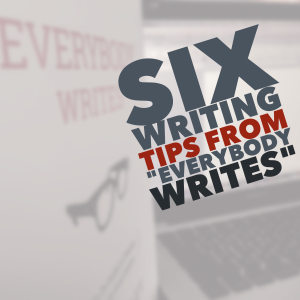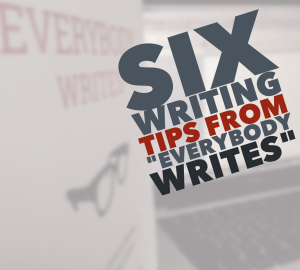For some reason, I always find myself in the same chaotic situation when it comes to industry books.
I have travels coming up.
I pack my new book just in case I can’t nap on the plane.
I start reading said book while the flight attendant explains that my faded navy, crumb-filled seat will save me during an emergency water landing. (Right.)
Two chapters in I realize that the book is a goldmine, and frantically discover I don’t have my pen, highlighter or post-it notes handy. Because they’re sitting on my desk, 30,000 feet below. (Fabulous.)
So I fold in pages here, crinkle up pages there, and completely destroy this new prized possession, all so I can go back and write down those insights when I land.
 That was the case last month when I read Ann Handley’s Everybody Writes on my flight from Cincinnati to Las Vegas. She calls it “your go-to guide to creating ridiculously good content,” and she’s right.
That was the case last month when I read Ann Handley’s Everybody Writes on my flight from Cincinnati to Las Vegas. She calls it “your go-to guide to creating ridiculously good content,” and she’s right.
It’s one of those books you keep handy at your desk, seated right next to your AP Stylebook. Each chapter features one helpful writing tip, ranging from common grammar errors to copyright issues for online publishers.
Looking at how many pages underwent my annotation-by-crinkle process, it’s obvious these writing tips hit home.
So this morning, I unfolded those pages, got out my trusty three-color highlighter and selected my favorite six lessons for today’s post.
1. Embrace “the ugly first draft.”
Procrastination is an evil, disruptive menace that writers know all too well. But did you know you can fight it with … barf?
That’s what Ann says, and I’m with her. Instead of waiting until you have that perfect moment, in which you’re not too hungry (but not too full), far enough from distractions (but have enough white noise), and well rested (but not too rested to the point of tired again), you should just barf up “the ugly first draft” (TUFD) with all of your thoughts so you have a starting place.
TUFDs aren’t cohesive, and they don’t have to sound intelligent. The TUFD is a no-excuses reason to get started instead of procrastinate. (It’s how I avoid all my annoying procrastination habits mentioned above, like not writing until I’m perfectly full but not stuffed … because that will make such a difference.)
2. Share specifics.
Details make a story stand out. So, when you’re writing your next piece of content, get as specific as you can. Ann quotes Natalie Goldberg as saying:
“Specify geranium instead of flower … substitute cocker spaniel for dog or write Vietnamese sandwich truck instead of food-truck service.” (pg. 66)
3. Add an element of surprise.
This is one way you can really get creative. Instead of providing that obvious analogy, brainstorm something offbeat that catches your audience’s attention. Ann suggests:
“Instead of: The leaves of the giant pumpkin plant are huge.
Try: The pumpkin leaves are the size of trash-can lids, covering pumpkins the size of beer kegs.” (pg. 70)
If that doesn’t nearly put you in the same room as those huge, Cinderella-esque pumpkins, I don’t know what will.
4. Test your content’s readability.
I’ll be honest. I had no idea Microsoft Office had a readability scoring tool. I always used the Hemingway App (or just relied on my own instincts) to determine whether my pieces were too wordy or jargon-filled.
But why not use a tool that’s already built into your writing software? Here’s a quick guide on how to activate yours.
5. Choose expressive verbs.
The best verbs are bold verbs. They follow tip number two by helping you visually tell your stories. Here are a few swaps Ann suggests, as well as a few of my own:
- Instead of “cut” her finger use “slashed.”
- Instead of “ran” through the airport use “sprinted.”
- Instead of “asked” him for more details use “pressed.”
Now, you may not have these all ready in your TUFD (and you shouldn’t, if you’re following the barf-up-content-quickly model). But they’re a good thing to add when you go through that first round of revisions.
6. Break some rules.
Back in elementary school, teachers lowered our grades for starting sentences with “because” or “and.”
But you know what? Times have changed, and professor Handley is in charge now.
Ann suggests throwing in some fragments, starting sentences with “but” when it feels right and opting for one-sentence paragraphs for effect. Today’s online readers don’t want your five paragraph essays, with three-sentence paragraphs.
They want it short, sweet and readable.
(See what I did there?)
When I first saw Ann speak about Everybody Writes at ASCEND Digital Marketing Summit, I had a feeling the book would be a winner. Now, after reading – and pretty much ruining – my entire copy in one sitting, I’d say my hunch was right.
As you’d expect, I’d highly recommend you go out and buy your own copy of “Everybody Writes,” because these six tips are only a starting point. Ann has 74 chapters that promise to make you ridiculously good at writing.
This post originally appeared on Stephanie Vermillion’s blog, PR State of Mind.
(257)







